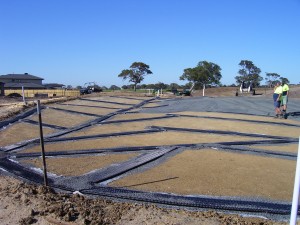
Designing putting greens is one of the most enjoyable and challenging tasks that a Golf Course Architect undertakes. Putting greens vary enormously from course to course and region to region depending on the natural terrain, climate and type of course. Many factors need to be considered when designing greens including the selection of the green site, the strategy of the particular golf hole, the extent of greenside bunkering, the location of adequate pin positions, the most suitable construction techniques, and the most appropriate grass types and the ongoing maintenance of the green complex.
When blessed with a natural site for a golf course the Architect’s challenge is to unearth the course and find the best possible layout that optimizes the site’s natural features and satisfies the requirements of a golf course. The early Architects like Old Tom Morris walked the land trying to find the green sites and then set about to link these into a layout that offered challenge, balance and variety. At Royal County Down at Newcastle in Northern Island Old Tom was given a budget of 4 pound to lay out the course. He managed to blow the budget and spent 4 pound 16 shillings but he was forgiven as he created a masterpiece that remains highly regarded today and a great example of working with nature.
Nowadays, the site for a new golf course is more likely to be an abandoned fish farm, a quarry or reclaimed land and all green sites have to imagined and made from scratch. On such sites the Architect will draw on a mental library of golf holes and green settings and try to recreate a suite of holes and greens that he feels suit the man made landscape in the hope that he can imitate nature. It is personally very satisfying when golfers comment on ‘what a great site you had ‘ when in fact the site was nothing but a tip site or a flooded tin mine.
Strategy is a major factor in green design and the green will be designed to accommodate a variety of pin positions that challenge golfers of all levels. The green will set up to accept or reject a certain type of shot and force the golfer to think carefully about his approach shot to the green. If the shot to the green is likely to be a 9 iron or less the green is usually small but a long par 3 demanding a 3 iron or more it is common for the putting surface to be much larger and the green set up less defensively. For example the famous ‘postage stamp’ par 3 at Troon is only 126 yards long but a minefield of hazards including bunkers, steep slopes and long rough surrounds the tiny green. In Championship golf, often there will be pin positions that are by design very difficult to get close to and it is better not to even try. This was evident at last month’s Open at St Andrews where the range of pin placements is enormous as are most of the greens. The largest green at St Andrews is over 4000 square meters whereas the typical green is around 600 square meters.
Variety is the key to making greens interesting. All 18 greens should be different and the Architect has many options at his disposal including size, shape, slope, and orientation towards the line of play. Similarly with the green surrounds, there are an infinite variety of bunker styles and configurations, hollows, mounds and drop offs. There should be a balance of greens that are either elevated, on grade and below the fairway approach.
The putting surfaces need to be of the highest quality and this can only be achieved if the greens are built properly and utilize a suitable grass. Grasses are either warm season grasses (Bermuda couch or paspalum) or cool season grasses (bent or fescue). Bent is the preferred grass but is too difficult to manage in hot tropical climates. The Bermuda grasses are generally much slower and develop a grain, which can cause inconsistent putting speeds. Putting speeds are measured by a stimp meter and speeds of say 9 feet are desirable. Speeds of up to 13 have been achieved for tournament play but it is dangerous practice as it puts the grass under a lot of stress and has led to the embarrassment of having to cancel play in windy conditions or extreme heat.
There are two main types of green construction – push up greens and USGA greens. Push up greens is the traditional method favoured on sandy sites and involves pushing up sand or free draining loam to form the green. USGA greens in contrast are usually formed on a clay base over which a pattern of drainage pipes and gravel are laid and covered with a layer of sand with a very particular specification which allows water to flow through the profile at an ideal infiltration rate. To maintain healthy turf grass the plant needs the appropriate amount of nutrient, air and water so greens are renovated regularly to ensure that these vital ingredients can get to the root zone. Deep occasional watering is desirable to ensure deep root growth and to avoid the build up of a thatch layer on the surface that is prone to disease and spongy surfaces. Shade is another enemy of healthy turf and morning sun is important if we are maintaining healthy firm putting surfaces.




